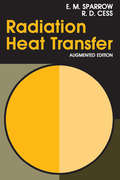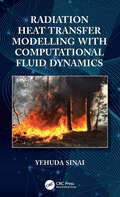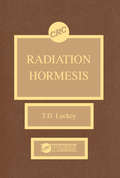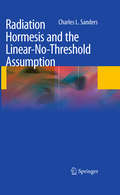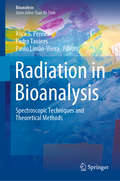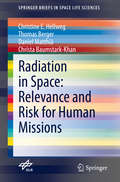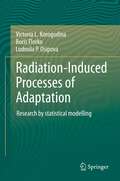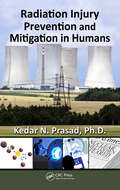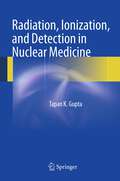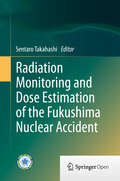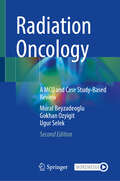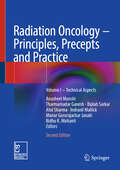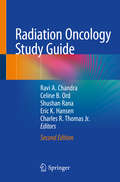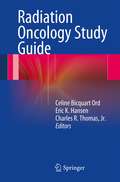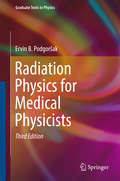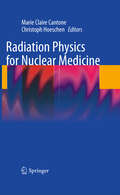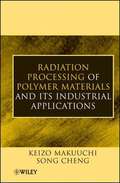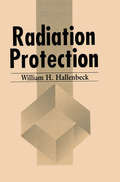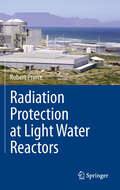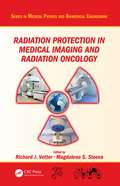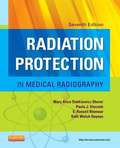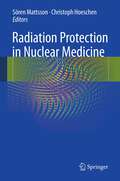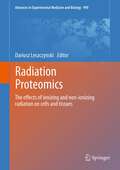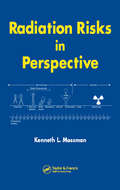- Table View
- List View
Radiation Heat Transfer, Augmented Edition
by E. M. SparrowRevised to include more information on analytical models for wavelength independence, Radiation Heat Transfer, Augmented Edition has been rearranged, providing problems within each chapter rather than at the end of the book. Written by Ephraim M. Sparrow, a generalist who works on a very broad range of problems that encompasses almost all mechanical engineering topics, the book presents key ideas without being exhaustive. Sparrow oversees the Laboratory for Heat Transfer and Fluid Flow Practice, whose function in to undertake both industrially bases and fundamental problems that fall within the bounds of heat transfer and fluid flow.
Radiation Heat Transfer Modelling with Computational Fluid Dynamics
by Yehuda SinaiThis book serves as a preliminary reference for the principles of thermal radiation and its modelling in computational fluid dynamics (CFD) simulations. Radiation Heat Transfer Modelling with Computational Fluid Dynamics covers strategies and processes for synthesizing radiation with CFD setups, computational techniques for solving the radiative transfer equation, the strengths and weaknesses thereof, boundary and initial conditions and relevant guidelines. Describing the strategic planning of a typical project, the book includes the spectroscopic properties of gases, some particulates and porous media. FEATURES Fills a gap between existing CFD and thermal radiation textbooks and elaborates on some aspects of user manuals. Aims at (1) CFD practitioners who are newcomers to thermal radiation and are looking for a preliminary introduction thereon and (2) modellers familiar with thermal radiation looking for a precursory introduction to CFD. The book is tilted somewhat towards the first group. Provides guidelines for choosing the right model, the strategic planning of the modelling and its implementation. Outlines the pitfalls of some solution techniques. Describes how radiation is included in the variety of boundary condition types offered by CFD codes. Helps to develop the practical skills required to plan, implement and interpret thermal radiation within the typical CFD code. Addresses a wide variety of physical circumstances in which thermal radiation plays a role. Offers ample references for readers searching for additional details. Includes several examples of practical applications, including fire, a utility boiler and car headlights in cold environments. This book is intended for researchers and professionals who wish to simulate problems that involve fluid flow and heat transfer with thermal radiation.
Radiation Hormesis (Routledge Revivals Ser.)
by T. D. LuckeyRadiation Hormesis presents the only critical review of the effects of whole-body exposure to low doses of ionizing radiation in animals. This is a "must read" book for radiobiologists, health-conscious individuals, and serious environmentalists. Topics discussed include our radiation environment, radiation hormesis in cancer mortality, growth and development, reproduction and mutation, immunity, and cancer. Data is presented that indicates that low doses of ionizing radiation may actually be beneficial to human health. This information could invalidate the "zero thesis" and linear models used by most regulatory agencies. The implications regarding eliminating linear models and accepting radiation hormesis are also discussed.
Radiation Hormesis and the Linear-No-Threshold Assumption
by Charles L. SandersCurrent radiation protection standards are based upon the application of the linear no-threshold (LNT) assumption, which considers that even very low doses of ionizing radiation can cause cancer. The radiation hormesis hypothesis, by contrast, proposes that low-dose ionizing radiation is beneficial. In this book, the author examines all facets of radiation hormesis in detail, including the history of the concept and mechanisms, and presents comprehensive, up-to-date reviews for major cancer types. It is explained how low-dose radiation can in fact decrease all-cause and all-cancer mortality and help to control metastatic cancer. Attention is also drawn to biases in epidemiological research when using the LNT assumption. The author shows how proponents of the LNT assumption consistently reject, manipulate, and deliberately ignore an overwhelming abundance of published data and falsely claim that no reliable data are available at doses of less than 100 mSv.
Radiation in Bioanalysis: Spectroscopic Techniques and Theoretical Methods (Bioanalysis #8)
by Alice S. Pereira Pedro Tavares Paulo Limão-VieiraThis book describes the state of the art across the broad range of spectroscopic techniques used in the study of biological systems. It reviews some of the latest advances achieved in the application of these techniques in the analysis and characterization of small and large biological compounds, covering topics such as VUV/UV and UV-visible spectroscopies, fluorescence spectroscopy, IR and Raman techniques, dynamic light scattering (DLS), circular dichroism (CD/SR-CD), pulsed electron paramagnetic resonance techniques, Mössbauer spectroscopy, nuclear magnetic resonance, X-ray methods and electron and ion impact spectroscopies. The second part of the book focuses on modelling methods and illustrates how these tools have been used and integrated with other experimental and theoretical techniques including also electron transfer processes and fast kinetics methods. The book will benefit students, researchers and professionals working with these techniques to understand the fundamental mechanisms of biological systems.
Radiation in Space: Relevance and Risk for Human Missions (SpringerBriefs in Space Life Sciences)
by Thomas Berger Christine E. Hellweg Daniel Matthiä Christa Baumstark-KhanThis volume of the series Springer Briefs in Space Life Sciences explains the physics and biology of radiation in space, defines various forms of cosmic radiation and their dosimetry, and presents a range of exposure scenarios. It also discusses the effects of radiation on human health and describes the molecular mechanisms of heavy charged particles’ deleterious effects in the body. Lastly, it discusses countermeasures and addresses the vital question: Are we ready for launch? Written for researchers in the space life sciences and space biomedicine, and for master’s students in biology, physics, and medicine, the book will also benefit all non-experts endeavouring to understand and enter space.
Radiation-Induced Processes of Adaptation: Research by statistical modelling
by Victoria L. Korogodina Ludmila P. Osipova Boris FlorkoIn recent decades radiobiologists' efforts have been directed at identifying the mechanisms of radiation effects; the general mechanisms have since been studied extensively. This book describes and analyzes radiation-induced adaptation as processes produced in cells, tissues, and populations. This viewpoint helps to understand the nature and factors of induced processes, to determine the characteristics of observed radiation effects and their limitations. The investigations presented here were founded on proper lab experiments, ecological studies of plant population growth near an operating nuclear power plant and a thorough epidemiological examination of human populations living in territories polluted fifty years ago, as well as on relevant published data. This research demonstrates the radiation-induced adaptation processes that continue even when the radiation itself is no longer at a critical background level. The investigations utilized the method of statistical modeling on the basis of distributions on the number of abnormalities. This method allows us to investigate the processes induced by low-dose factors when accompanied by Darwinian selection in different systems; the distribution parameters can then be used to study the characteristics of adaptation processes and system resistance. The consequences of background-level radiation continue to provoke debate, and the mathematical bases of the adaptation model are shown, while due consideration is paid to the components of adaptation: instability, selection, and proliferation. The book will be especially useful to specialists in radiation pollution, ecology, epidemiology, and radiology for studies of radiation-induced processes; the method presented here can also be adapted to investigate low-dose effects in other fields. In addition, the book presents a number of reviews in the fields of radiation biology, including pioneering investigations in Russia which were previously unavailable to Western scientists.
Radiation Injury Prevention and Mitigation in Humans
by Kedar PrasadWith an estimated 3.3 billion ionizing radiation imaging examinations performed worldwide each year, the growing use of x-ray-based diagnostic procedures raises concerns about long-term health risks, especially cancer. In addition, rapid growth in the number of nuclear power plants around the world increases the risk of a nuclear accident similar t
Radiation, Ionization, and Detection in Nuclear Medicine
by Tapan K. GuptaThis book will serve as the definitive source of detailed information on radiation, ionization, and detection in nuclear medicine. It opens by considering fundamental aspects of nuclear radiation, including dose and energy, sources, and shielding. Subsequent chapters cover the full range of relevant topics, including the detection and measurement of radiation exposure (with detailed information on mathematical modelling); medical imaging; the different types of radiation detector and their working principles; basic principles of and experimental techniques for deposition of scintillating materials; device fabrication; the optical and electrical behaviors of radiation detectors; and the instrumentation used in nuclear medicine and its application. The book will be an invaluable source of information for academia, industry, practitioners, and researchers.
Radiation Monitoring and Dose Estimation of the Fukushima Nuclear Accident
by Sentaro TakahashiThis book provides comprehensive research findings related to the environmental monitoring of radiation, levels of radioactive nuclides in various environments and dose estimation in residents after the Fukushima nuclear power plant accident caused severe environmental contamination with radioactive nuclides. At the beginning of the book, a technical review written by a leading researcher of nuclear reactor technology explains what happened at the power plant. The review is followed by a commentary from a former member of the International Commission on Radiological Protection, providing the reader with easily understandable information about the concept of radiation dosage. In the main part of the book, a series of scientific reports presents valuable data on the radiation surveys of the environment, environmental radioactivity, transfer models and parameters of radioactive nuclides and dose assessment among residents. These reports present a wide range of findings from the research carried out in a variety of activities by large governmental organizations as well as by small private groups and individuals. The reader thus will find a large collection of valuable and interesting data related to the environmental contamination by radioactive nuclides after the Fukushima accident. Although earlier reports on this issue have been made public, this book is the only publication to fully depict the actual situation by providing comprehensive data obtained by diverse organizations and individuals.
Radiation Oncology: A MCQ and Case Study-Based Review
by Murat Beyzadeoglu Gokhan Ozyigit Ugur SelekThis updated work is an all-in-one board examination preparation book, arranged in an MCQ examination pattern instead of old-style question and answer format complemented by oral exam questions designed to meet the needs of a wide range of examinees. Radiation Oncology: A MCQ and Case Study-Based Review 2nd edition will meet the need for a practical, up-to-date, bedside-oriented radiation oncology book. Essential aspects of radiation physics, radiobiology, and clinical radiation oncology are well covered. Tumors at different sites are adressed in a series of individual chapters, and further chapters are devoted to lymphomas and total body irradiation, pediatric tumors and benign diseases. The answer keys provide clear explanations for both the correct answers and incorrect statements. It will be extremely useful for residents, fellows, and clinicians in the fields of radiation, medical, and surgical oncology, as well as for medical students, physicians, and medical physicists with an interest in clinical oncology.
Radiation Oncology – Principles, Precepts and Practice: Volume I – Technical Aspects
by Anusheel Munshi Tharmarnadar Ganesh Biplab Sarkar Atul Sharma Indranil Mallick Manur Gururajachar Janaki Bidhu K. MohantiThis book covers various aspects of radiation oncology, its principles and practice in the management of cancer types and sites in the human body. The book is in two volumes: Volume One is devoted to basic and technical aspects; Volume Two provides the clinical basis of modern radiation oncology. The chapters focus on an evidence-based multidisciplinary approach to cancer management covering the indications, contouring, treatment technique, outcomes, and toxicities related to radiotherapy for various cancer sites. It includes separate chapters on radiation biology, physics, and palliative care. Additionally, the book also addresses contemporary topics including artificial intelligence in radiation oncology, the role of protons/heavy ions, and the conduct of clinical trials in radiation oncology. The book is a relevant resource for busy radiation oncology physicians, practitioners, and trainees/residents/fellows seeking to utilize evidence in the literature to guide the management of radiation therapy patients. The book can be valuable for other disciplines such as surgical oncology, medical oncology, palliative medicine in cancer management including basic scientists working in both developed and developing countries.
Radiation Oncology Study Guide
by Charles R. Thomas Jr. Eric K. Hansen Ravi A. Chandra Celine B. Ord Shushan RanaNow in its second edition, this popular text remains a comprehensive study and review aid for the radiation oncology trainee and practicing radiation oncologist. The updated Radiation Oncology Study Guide, 2e maintains its robust Q&A format, and has been comprehensively updated to include the latest staging information and treatment methods. Answer rationales have been modified to a more readable, high yield bulleted format.Each chapter covers a major disease site and is divided into two main parts: Questions & Answers and Rationale. Questions review the scope of clinical practice, spanning from initial presentation to complications of treatment. General content and work-up questions emphasize “pearls” of epidemiology, anatomy, pathology, clinical presentation, and staging. Treatment content questions not only review evidence-based data guiding treatment recommendations, but also practical aspects of radiation treatment planning, pertinent radiobiology and physics, and complications of treatment. This book is an ideal resource for physicians-in-training to prepare for initial written and oral exams and physicians in practice to maintain their skills and prepare for maintenance of certification longitudinal and written exams.
Radiation Oncology Study Guide
by Charles R. Thomas Jr. Eric K. Hansen Celine Bicquart OrdRadiation Oncology Study Guide is a comprehensive study aid for radiation oncology residents preparing for the American Board of Radiology Radiation Oncology Initial Certification board exam. Presenting the fundamental principles of radiation oncology, the book covers the most salient and commonly tested facts on the exam. Organized by specific disease sites, each chapter presents a series of questions and answers that present clinical features, staging, principles of treatment, and evidence-based studies that guide treatment recommendations, with an emphasis on radiotherapy studies. The book offers over 1,000 multiple-choice questions with detailed answers and rationales.
Radiation Physics for Medical Physicists
by Ervin B. PodgoršakThis textbook summarizes the basic knowledge of atomic, nuclear, and radiation physics that professionals working in medical physics and biomedical engineering need for efficient and safe use of ionizing radiation in medicine. Concentrating on the underlying principles of radiation physics, the textbook covers the prerequisite knowledge for medical physics courses on the graduate and post-graduate levels in radiotherapy physics, radiation dosimetry, imaging physics, and health physics, thus providing the link between elementary undergraduate physics and the intricacies of four medical physics specialties: diagnostic radiology physics, nuclear medicine physics, radiation oncology physics, and health physics. To recognize the importance of radiation dosimetry to medical physics three new chapters have been added to the 14 chapters of the previous edition. Chapter 15 provides a general introduction to radiation dosimetry. Chapter 16 deals with absolute radiation dosimetry systems that establish absorbed dose or some other dose related quantity directly from the signal measured by the dosimeter. Three absolute dosimetry techniques are known and described in detail: (i) calorimetric; (ii) chemical (Fricke), and (iii) ionometric. Chapter 17 deals with relative radiation dosimetry systems that rely on a previous dosimeter calibration in a known radiation field. Many relative radiation dosimetry systems have been developed to date and four most important categories used routinely in medicine and radiation protection are described in this chapter: (i) Ionometric dosimetry; (ii) Luminescence dosimetry; (iii) Semiconductor dosimetry; and (iv) Film dosimetry. The book is intended as a textbook for a radiation physics course in academic medical physics graduate programs as well as a reference book for candidates preparing for certification examinations in medical physics sub-specialties. It may also be of interest to many professionals, not only physicists, who in their daily occupations deal with various aspects of medical physics or radiation physics and have a need or desire to improve their understanding of radiation physics.
Radiation Physics for Nuclear Medicine
by Christoph Hoeschen Marie Claire CantoneThe field of nuclear medicine is expanding rapidly, with the development of exciting new diagnostic methods and treatments. This growth is closely associated with significant advances in radiation physics. In this book, acknowledged experts explain the basic principles of radiation physics in relation to nuclear medicine and examine important novel approaches in the field. The first section is devoted to what might be termed the "building blocks" of nuclear medicine, including the mechanisms of interaction between radiation and matter and Monte Carlo codes. In subsequent sections, radiation sources for medical applications, radiopharmaceutical development and production, and radiation detectors are discussed in detail. New frontiers are then explored, including improved algorithms for image reconstruction, biokinetic models, and voxel phantoms for internal dosimetry. Both trainees and experienced practitioners and researchers will find this book to be an invaluable source of up-to-date information.
Radiation Processing of Polymer Materials and Its Industrial Applications
by Song Cheng Keizo MakuuchiUp-to-date, comprehensive coverage on radiation-processed polymer materials and their applicationsOffering a unique perspective of the industrial and commercial applications of the radiation processing of polymers, this insightful reference examines the fundamental scientific principles and cutting-edge developments advancing this diverse field. Through a variety of case studies, detailed examples, and economic feasibility analysis, Radiation Processing of Polymer Materials and Its Industrial Applications systematically explains the commercially viable ways to process and use radiation-processed polymeric materials in industrial products. In addition, this one-of-kind text:Covers important chemistry and processing fundamentals, while emphasizing their translation into practical applications of radiation-processed polymersIncorporates new applications in nanotechnology, biomaterials, and recyclingSystematically discusses new developments in the field and summarizes past achievementsBy helping readers--from students to scientists, engineers, technicians, and sales and marketing professionals--understand and solve problems associated with radiation processing of polymers, Radiation Processing of Polymer Materials and Its Industrial Applications serves as an essential reference and fills an important gap in the literature.
Radiation Protection
by William H. HallenbeckThis text/reference provides an excellent introduction to fundamental topics in radiation protection, including energetics, kinetics, interaction, external radiation protection, dosimetry, standards, and measurement. Chapters on radioactive waste and radon, topics not normally covered in introductory texts, have been incorporated as well. An extensive glossary of terms, abbreviations, acronyms, physical constants, units, and unit conversions provides a ready source of frequently needed information. Several appendices contain specifications and vendors for commercially available portable radiation survey instruments, personal dosimeters, and radon/radon progeny monitors.
Radiation Protection: A Guide for Scientists, Regulators, and Physicians, Fourth Edition
by Jacob ShapiroThis highly successful manual has served for nearly three decades as the definitive guide to the safe use of radioactive materials. Completely revised and updated, the fourth edition presents a new dimension by adding coverage of nonionizing radiation, and is thus concerned with the entire field of radiation protection. The author takes the novel approach of introducing the whole range of energies possessed by particles and electromagnetic waves at the beginning of the text, thus integrating coverage of ionizing and nonionizing radiation rather than considering them as two separate disciplines. He goes on to cover the entire spectrum of radiation sources, including radionuclides, x-ray machines, accelerators, nuclear reactors, power lines, microwave towers, and cellular phones. With its expanded coverage, including a broader focus on public health issues, this new volume will serve as an important training and reference resource, not only for research scientists, physicians, and engineers, but for regulatory officials, attorneys, engineers, and environmental health and safety professionals. The breadth of citations alone makes this resource invaluable.
Radiation Protection at Light Water Reactors
by Robert PrinceThis book is aimed at Health Physicists wishing to gain a better understanding of the principles and practices associated with a light water reactor (LWR) radiation protection program. The role of key program elements is presented in sufficient detail to assist practicing radiation protection professionals in improving and strengthening their current program. Details related to daily operation and discipline areas vital to maintaining an effective LWR radiation protection program are presented. Programmatic areas and functions important in preventing, responding to, and minimizing radiological incidents and the importance of performing effective incident evaluations and investigations are described. Elements that are integral in ensuring continuous program improvements are emphasized throughout the text.
Radiation Protection in Medical Imaging and Radiation Oncology (Series in Medical Physics and Biomedical Engineering)
by Richard J. VetterRadiation Protection in Medical Imaging and Radiation Oncology focuses on the professional, operational, and regulatory aspects of radiation protection. Advances in radiation medicine have resulted in new modalities and procedures, some of which have significant potential to cause serious harm. Examples include radiologic procedures that require ve
Radiation Protection in Medical Radiography
by Mary Alice Statkiewicz Sherer Paula J. Visconti E. Russell Ritenour Kelli HaynesRadiation Protection in Medical Radiography, 7th Edition makes it easy to understand both basic and complex concepts in radiation protection, biology, and physics. Concise coverage promotes the safe use of ionizing radiation in all imaging modalities, including the effects of radiation on humans at the cellular and systemic levels, regulatory and advisory limits for human exposure to radiation, and the implementation of radiation safety practices for patients and personnel. This edition includes NEW content on the impact of radiation levels during the nuclear power plant crisis that followed the 2011 earthquake/tsunami in Japan. From an author team led by well-known radiation protection expert Mary Alice Statkiewicz Sherer, this text has consistently helped students perform well on the ARRT exam! Convenient, easy-to-use features include chapter outlines and objectives, highlighting of key terms, and bulleted summaries and review questions to enhance comprehension and retention. Clear and concise writing style covers complex concepts in radiation protection, biology, and physics in a building-block approach from basic to more complex concepts. Review questions are included at the end of chapters to assess your comprehension, with answers on the Evolve companion website. Coverage of historical radiological disasters includes photos and text on Hiroshoma, Chernobyl, and Three-Mile Island. UPDATED! NCRP and ICRP content includes guidelines, regulations, and radiation quantities and units, explaining the effects of low-level ionizing radiation, demonstrating the link between radiation and cancer and other diseases, and providing the regulatory perspective needed for practice. NEW! Discussion of Total Effective Dose Equivalent (TEDE) covers the radiation dosimetry quantity defined by the U. S. Nuclear Regulatory Commission to monitor and control human exposure to ionizing radiation.
Radiation Protection in Nuclear Medicine
by Christoph Hoeschen Sören MattssonThis book explains clearly and in detail all aspects of radiation protection in nuclear medicine, including measurement quantities and units, detectors and dosimeters, and radiation biology. Discussion of radiation doses to patients and to embryos, fetuses, and children forms a central part of the book. Phantom models, biokinetic models, calculations, and software solutions are all considered, and a further chapter is devoted to quality assurance and reference levels. Occupational exposure also receives detailed attention. Exposure resulting from the production, labeling, and injection of radiopharmaceuticals and from contact with patients is discussed and shielding calculations are explained. The book closes by considering exposure of the public and summarizing the "rules of thumb" for radiation protection in nuclear medicine. This is an ideal textbook for students and a ready source of useful information for nuclear medicine specialists and medical physics experts.
Radiation Proteomics
by Dariusz LeszczynskiMethods of proteomics have been shown to be powerful tools in search of target proteins - proteins that respond in cells to an internal or an external stimulus. Proteomics is widely used in biomedical research. However, in radiation biology research, following exposures of living matter to low doses of either ionizing or non-ionizing radiation, proteomics approach is only very slowly gaining support. This book, by presenting the current status of the use of proteomics in radiation biology, will help to attract attention to the field of radiation proteomics.
Radiation Risks in Perspective
by Kenneth L. MossmanPublic misperception of radiological risk consistently directs limited resources toward managing minimal or even phantom risks at great cost to government and industry with no measurable benefit to overall public health. The public's inability to comprehend small theoretical risks arrived at through inherently uncertain formulae, coupled with an ir
